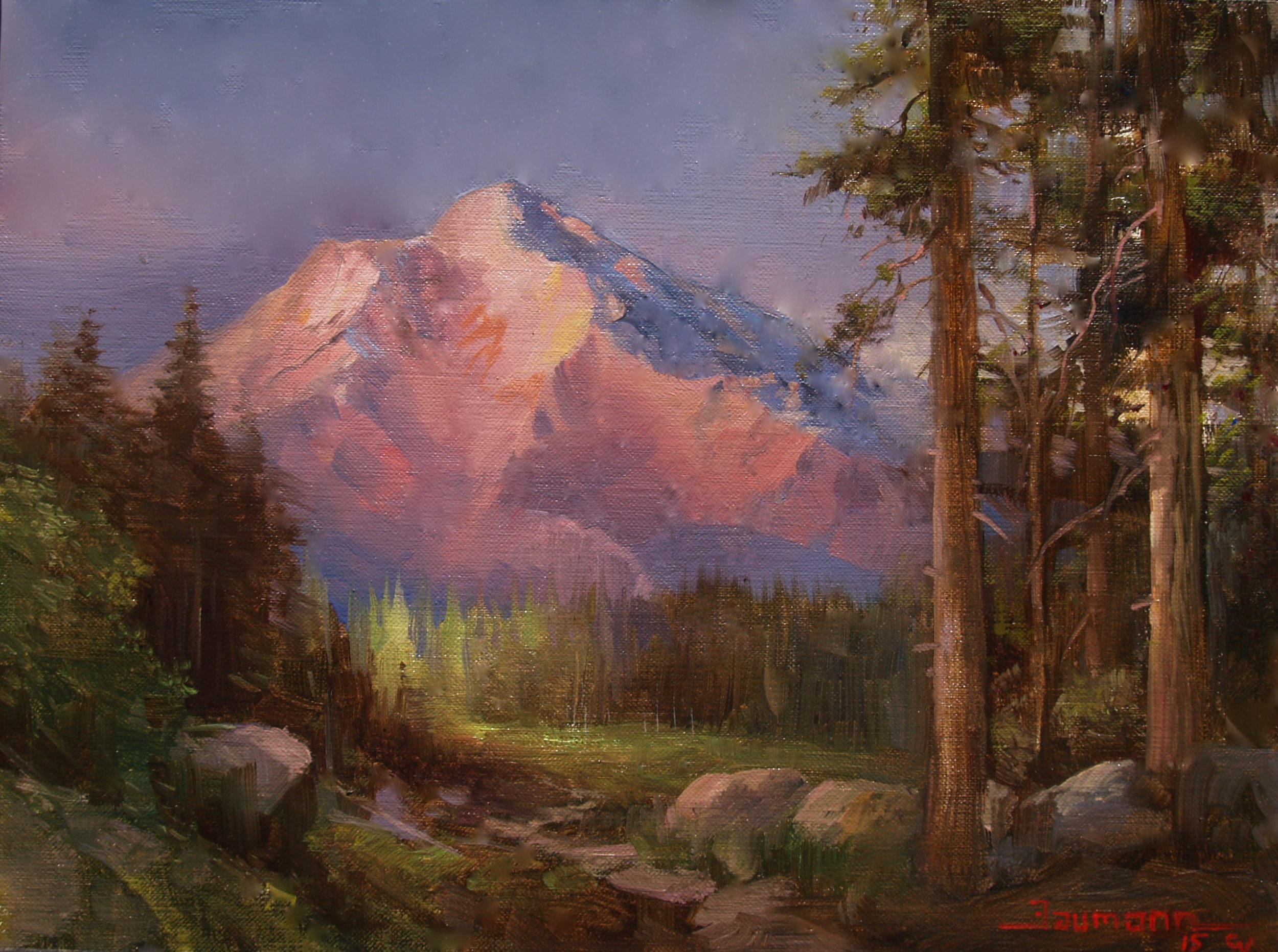Sunset at Panther Meadows, Mt. Shasta
The smoke from the fires in Northern California is extreme. At times you can see only a mile ahead and it has made it difficult to feel inspired to paint outdoors. The dense smoke and ash falling from the sky constantly reminds me the losses others are suffering during this summer of great drought and fires.
During the last few nights, the smoke lifted allowing me to steal away with my new Strada Pochade box to paint on the slopes of Mt Shasta. The smoke in the atmosphere blends with the light of the setting sun creating a beautiful “alpine glow” lighting effect on Mt Shasta, making the light seem even more spectacular than usual. The smoke adds a subtle color to the atmosphere and it is this pollution that we see in the paintings of Albert Bierstadt and Frederic Church. Not only did these early artists live in a time of great wildfires on the plains, they also had the resulting pollution generated from occasional volcanic eruptions.
It has been my experience that the best time to paint is in the morning and evening. The angle of the sun at these times of day creates the best shadows and interesting light patterns. Painting in the evening is my favorite time to paint on location. The light travels slower and the colors are more vivid than any other time of day. I have extra time to think of a concept, set the stage with a sketch, and mix colors before I begin painting the subject. This first 10 minutes of preparation before painting is critical and mandatory. I encourage students in my plein air workshops to take even more time before sketching their composition. Light, as I explain in my You Tube videos and at my Plein Air Workshops, is essential when creating a stunning painting. In fact, a painting without the effect of light will be a painting of things – a rock, a tree, a mountain, etc. Great artists don’t paint things, they paint the effects of the light and how it illuminates things to make a stunning, eye-catching painting.
I had the good fortune of witnessing the sun setting from my studio window at The Grand View Ranch and saw an awesome lighting effect generated by the light filtering through the smoke from the fires in Northern California. I knew that if the smoke cleared, the colors of the sky the following evening would be amazing. I am always looking for stunning locations with good lighting to share with students when they attend my painting workshops in Mt. Shasta. One location that I have been looking forward to exploring for years is called Panther Meadows. This place is considered sacred by many people around the world, and I am amazed by the number of people who travel here to see Mt. Shasta and to learn the secrets of painting on location.
These are a few pointers that we talk about during the workshop:
Begin by painting footnotes where the light and dark patterns are.
Squint! Squinting softens your focus to see value and not color.
Paint the shadows patterns first because they will change rapidly outdoors. Link the shadows together to simplify the pattern.
Establish the main color of the light source.
Establish the main color of the shadow of the distant value.
Look for the lightest light and the darkest dark and see if you can increase the contrast to create strong contrast and excitement in your painting.
Determine the central focal point and limit your central focal point to one strong idea somewhere in the middle of the painting.
Make sure your first color note is accurate and compare every additional color note to that.
Tragically this summer wildfires have burned many locations in the west; however there is a silver lining for the artist. The effects generated by the smoke-filtered light can produce stunning effects in your paintings. So, go out and paint. And if you need some additional motivation, attend my workshop in October in Mount Shasta. The information is located under Workshops on my website at www.StefanBaumann.com.
(Note: The Strada outdoor pochade box is fantastic! It is sturdy and strong with very little shaking and rattling like my Open Box M. It is easy to set up and to clean. Strada has made a modern quality box that fixes issues that I have had with Plein Air Boxes made with wood, springs and screws.)
_______________________________________________________
Plein air and alla prima artist Stefan Baumann, host of the PBS painting series “The Grand View, America’s National Park through the eyes of an artist” and author of “Observations Of Art and Nature,” travels in his vintage travel trailer painting America’s western landscape. Baumann paints outdoors with oils and canvas capturing stunning vistas, wildlife, western landscapes, National Parks and still life, thrilling art collectors throughout the world. He has many international collectors acquiring his paintings as investments. His painting style is called Romantic Realism with Luminism, and the extraordinary way he captures the effect of light is a truly American style used to paint the Western landscape. He can be seen plein air painting in Yellowstone, Yosemite and in the Grand Canyon. Baumann’s “how to paint” DVDs filmed on location in the National Parks are the very best on the market.

